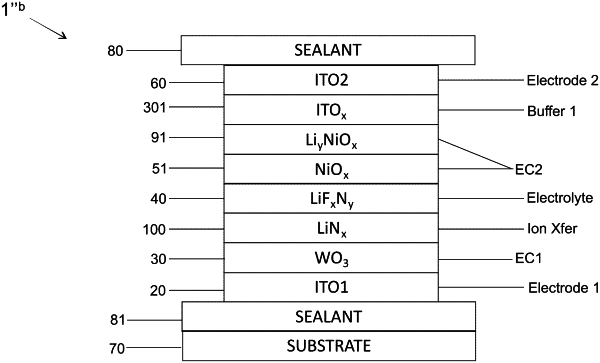| CPC G02F 1/157 (2013.01) [E06B 9/24 (2013.01); G02C 7/101 (2013.01); G02F 1/1525 (2013.01); G02F 1/155 (2013.01); H02S 40/22 (2014.12); E06B 2009/2464 (2013.01); G02F 2001/1555 (2013.01)] | 33 Claims |

|
1. An electrochromic device included within another device, the electrochromic device comprising:
a first transparent electrode comprised of a conductive metal oxide, the first transparent electrode is configured to selectively gain and/or lose electrons upon selective application of electrical potential to the electrochromic device;
a first electrochromic layer formed on and in electrical contact with the first transparent electrode, the first electrochromic layer is configured to reversibly change from a colored state to a transparent state upon loss of a first amount of ions and electrons from the first electrochromic layer upon selective application of electrical potential to the electrochromic device;
an electrolyte layer formed on the first electrochromic layer and positioned between the first electrochromic layer and a second electrochromic layer, the electrolyte layer is configured to selectively transfer ions from the first electrochromic layer to the second electrochromic layer upon selective application of electrical potential between the first electrode and a second transparent electrode to change the electrochromic device from a low transparency state of approximately 10-20% transmittance in the visible region to a high transparency state of approximately 75% to 95% transmittance in the visible region with at least a 70% difference in transmittance between the low and high transmittance states;
the second electrochromic layer formed on the electrolyte layer, the second electrochromic layer comprises an electrochromic metal oxide and is configured to reversibly change from a colored state to a transparent state upon gaining an amount of ion-electron pairs that coincides with the loss of the first amount of ion-electron pair from the first electrochromic layer upon selective application of electrical potential to the electrochromic device;
a buffer layer formed on the second electrochromic layer and positioned between the second electrochromic layer and the second transparent electrode that is configured to maintain conductivity and stability of the electrochromic device while in use; and
the second transparent electrode formed on the buffer layer and in electrical contact with the second electrochromic layer, the second transparent electrode comprises the same conductive metal oxide as the first transparent electrode and is configured to selectively gain and/or lose electrons upon application of selective electrical potential to the electrochromic device, wherein:
the buffer layer promotes electron transfer between the second transparent electrode and second electrochromic layer while concurrently reducing or inhibiting deleterious chemical interaction between the second electrochromic layer and the second electrode and/or maintaining the conductive state of the second electrode while the electrochromic device changes from the low transparency state to the high transparency state, and
the another device comprises a mirror, an optical filter, or photovoltaic device.
|